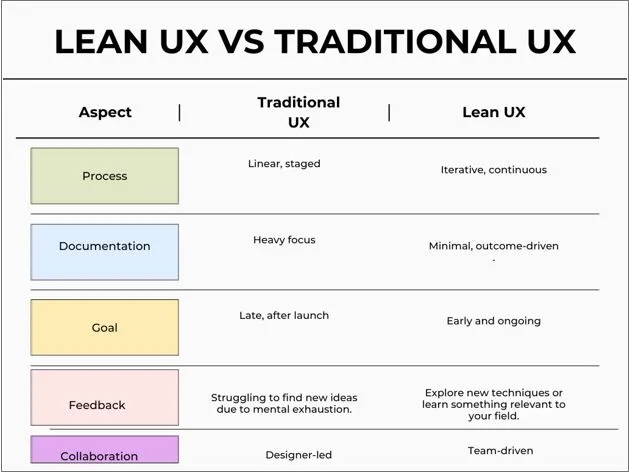What is Lean UX Design?
Lean UX design is a contemporary approach to UI UX design services that emphasizes speed and collaboration. The premise is to abandon unnecessary documentation. Rather than working through the theatre of beautiful deliverables, Lean UX design promotes building prototypes quickly, validating with actual users, and then—here’s the interesting part—iterating after learning from that validation.
Lean UX design is founded on the thinking of the Lean Startup movement and Agile software development concepts. What’s the end goal? To cut waste, validate our terrifyingly costly ideas sooner, and, somehow, deliver user value more quickly. For businesses seeking better outcomes, combining Lean UX with professional UI UX design services can create stronger, user-focused products.
But Lean UX design? Its focus is more on insights and learning than on perfection. It shifts the focus of the design process from, “Look at this pretty thing we designed!” to, “Did that pretty thing we designed actually move the needle?” Lean UX is about outcomes, not deliverables.
Core Purpose of Lean UX in Product Development
Lean ux design is meant to enable a product’s design meets the needs of the user’s and to also reduce the waste of time and money. Instead of trying to arrive at a ‘final’ design that is perfect to use, teams learn from users in the field and then iterate.
In product development, Lean UX’s core objectives are to:
- Quickly validate assumptions;
- Discover products that solve real user problems;
- Build collaboration among cross-functional team members;
- Take action based on measurable user and business outcomes.
Lean UX lends itself to limiting feature bloat and helps to redirect development resources towards outcomes that matter. For example, Spotify roleouts out new features in smaller markets first, studies the behavior of users on that product feature, and then builds out globally if users find it useful.
If your organization is using user interface design services or mobile ui ux design services, these principles should help ensure you are learning and validating strategies before they reach the wider user base.
Why Lean UX Matters in Modern Product Design
The environment of digital products scales at a rapid pace and the product teams do not have the luxury of taking years to perfect a product design for launch. The question arises as to why lean UX design services are important now?
- Faster Time-to-Market – Lean UX ideates and delivers products or features to market quickly based on eliminating unnecessary steps and concentrating on what is really matters.
- Lower Risk – Testing assumptions up-front protects teams from investing a lot of time and effort in ideas that ultimately don’t work.
- Customer Focused – Embedding direct user feedback ensures you create products to meet real user needs, not assumptions about their needs.
- Agility – Teams can pivot quickly when feedback shows user needs are different than they had thought.
Modern power companies like Airbnb and Amazon have built their businesses by iterating, experimenting, and applying lean user experience learning to constantly maintain user satisfaction while maximizing growth globally. Companies today are also experiencing the same benefits when engaging a ux design service, product design service, or a ux consulting service to apply the principles of lean user interface experience in a practical world product strategy with good outcomes of innovation and business value.
Lean UX vs Traditional UX
Lean UX vs Traditional UX
Lean UX and Traditional UX represents the differences between a validated learning, iterative approach to the UX design process and a prescriptive, documents-based approach. Traditional UX values process: virtual thinking and comprehensive flows. Lean UX values more testing, prototyping, collaboration and a simplified process. As a result, Lean UX is much more flexible, efficient, and relevant to today’s UI/UX capabilities.
Key differences in process, mindset, and outcomes:
Example: A banking application built traditionally could take 12 months and not be tested until the end of the process. With the lean ux design process, we could test prototypes in weeks leading to optimally better insights, investing smarter, and delivering production quicker.
Lean UX Process: Think, Make, Check
The process to use for Lean UI/UX design is simple, but very powerful. The cycle is simply this – Think → Make → Check.
Step 1: Think – Research, Assumptions, & Hypotheses
This is the phase where you’re framing a problem, and making hypotheses. Instead of writing everything down, teams will ask:
- What do we believe about the user?
- How can we test if that is true?
Example: “We believe we will drive more completed purchases by reducing our checkout process from 5 steps to 2 steps.”
Step 2: Make – Rapid Prototyping & MVP’s
Teams will create quick iterations of their prototypes or MVP’s (Minimum Viable Product). The purpose of this step is not to achieve perfection, but to put something in front of the user to test the assumption.
Example: Dropbox created a demo video as opposed to actually building out a full product to validate user demand, before putting in further investment to develop.
Step 3: Check – Testing, Feedback, & Iteration
Teams will now be testing the prototypes with users. The team will then go back to the drawing board, determine next steps, pivot, or refine the current idea.
This cycle continues until the product has been validated through user feedback and business outcomes. Organizations that provide professional mobile app development services and ui ux design services typically follow this process in order to shorten the time it takes to build their products, ensuring that they are user-centered and ready for the market.
Advantages of Lean UX in Product Design
The whole premise of Lean UX design is to be effective and spare us from ourselves. It is supposed to function systematically in the opposite manner of a particular chaotic- and disorganized product launch.
- Quicker Decision-Making: This is the best part. Rapid prototyping and testing are a means of validating concepts early. No more weekly meetings debating whether or not to eliminate a feature we should have been dropped in the first week. It is just quick, decisive action. That speed is off-putting a little, but necessary.
- Lowered Risks/Wasted Efforts: Testing assumptions on live users gives the team the opportunity to not build features that literally don’t add value. Think of all the code you won’t need to write! The cake of your mini existential crisis you had when a gigantic project gets shut down after six months of work can, now and more effectively, be fully avoided!
- Better Collaboration: Lean UX brings together-as in cross collaboratives-product development by design. The idea is that everyone is literally, “aligned and focused on shared goals.” (Lol, good luck getting to true alignment, but it helps some.) The anxiety of misaligned expectations is somewhat relieved.
- Customer-Focused Results: Regular feedback loops with users generate products that actually meet a customer’s need. After all, the user is the last word; sometimes, even when they ask for something, they can’t articulate it well and it not so easy to discern as to why it is confusing.
- Smarter Resource Allocation: You will focus your energy on the “high impact features” instead of all the details that have low impact. It’s about using resources in the places that actually matter.
- Greater Flexibility & Adaptability: They say “iterative testing makes it easier to change directions.” This is the anti-fragile quality that every product needs; the capacity to pivot without having to completely restart the whole infrastructure.
- Competitive Advantage: You are able to deliver quicker and you design products based on user validation; this makes you launch a better product. You have an assured leg up.
Anyway, the point is companies get that all these ideas mixed in with product design services and user interface design services done using Lean UX practices will grab that much needed competitive advantage.
Conclusion
Lean UX is no longer a “nice to have” for product teams today, it’s required. It enables teams to design faster, reduce risk, and launch products customers actually want. No product team today can ignore the importance of Lean UX in an increasingly competitive world.
Final thoughts on how to be successful with Lean UX
Moving to lean user experience is much more than running new tools; it is a total mindset shift. Your teams have to be prepared for experimentation, focus on outcomes rather than output, and view failure as just another opportunity to learn.
But organizations such as Spotify, Netflix, and Amazon have already shown that they have a better edge over their competitors by embracing Lean UX thinking because they can respond to their customers faster. Combining ui ux design services and ux consulting services into lean ux design process gives product teams speed and collaboration to create positive experiences that have an engaging impact.






